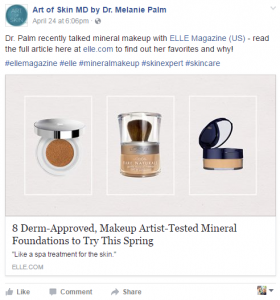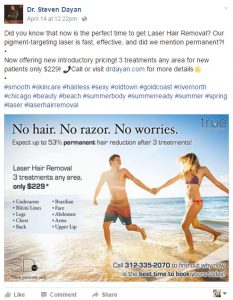You’ve got the big picture figured out – you’re ready to jump in to the world of social media and connect with your patients through their favorite social platform. You’ve even figured out which platforms you’ll be using, what your goals are and who you want to engage with on each page. Your status updates and Tweets won’t write themselves, however, so it’s time to fine tune your strategy and determine exactly what you want your posts to say.
In part two of our series, we have advice on scheduling posts and creating a professional yet personal voice and style, as well as ideas for posts that will captivate and engage your followers.
Step 1 – Establish a schedule – and stick to it.
Scheduling is a social media strategist’s best friend. Make sure that whoever is in charge of your social media pages sets aside time each day to dedicate to social media management. Whether its ten minutes or one hour, spending time on the pages each day will give a better understanding of what’s happening with your fans. During this time, check Facebook, Instagram and Twitter feeds to see what other people are posting and respond to any comments or reviews on your pages. You should also spend time on similar pages as well as your competitors’ pages to see what kind of content they are posting.
Next, establish a posting schedule that can be maintained consistently. Once the pages start gaining followers, Facebook Insights and Twitter Analytics can tell you what days and times your fans are online. Use this data to create a schedule that will guarantee that your followers see your posts.
When planning your schedule, focus on quality rather than quantity. Two or three posts per week with high engagement are much more effective than daily posts with low engagement. Too few posts won’t be effective and too many posts will overwhelm your followers. Find a balance that fits your audience.
Step 2 – Maintain a professional yet personal voice.
While you and your team most likely have experience posting on your personal pages, posting as a business requires a different approach. When you’re just beginning your social media journey, it’s important to have a discussion about what you want the voice of your page to be. First and foremost, your posts, status updates and interactions with fans should always be professional and courteous – but don’t get too caught up in creating a business-like persona. The “social” part of social media is all about connecting with people; fans want to know that there are real people behind the businesses they support.
· Use a conversational tone when posting and responding to comments from fans. Avoid using unnecessary jargon and medical terms that will overwhelm or confuse people.
· Share photos of your staff around the office and at events in the community. Your patients see your staff members when they visit the office and seeing these familiar faces on their news feed makes them more likely to interact with your pages.
· Utilize patient testimonials and reviews. Customer reviews give your page a personal touch and are one of the most influential tools at your disposal. They are also one of the driving forces behind gaining new customers.
Step 3 – Create a variety of content that will engage your followers.
This may seem easier said than done but once your pages begin to gain momentum, you’ll be able to see which types of content your audience responds to most often. Consider a variety of content for your pages.
1. Before and after images. When it really comes down to it, your patients want to know whether or not the treatments they’ll receive from you will actually work. A transformative before and after image from a filler, acne treatment or body sculpting procedure will make them pause while they’re scrolling through their newsfeed – which is exactly what you want.
Source – Facebook – Dr. Joel Schlessinger
2. Expert advice. You’re an expert in your field and your patients should know it. Sharing links to articles in which you are quoted, photos of you presenting at conferences and studies that you have collaborated on highlight your expertise and recognition as a physician.
Source – Facebook – Art of Skin by Dr. Melanie Palm
3. Video content. Video content is quickly becoming the most popular type of content on social media. Whether the video has been created by you and your team or you’re sharing someone else’s video, it’s an effective way to get people to pause and look at your posts.
Source – Facebook – Miami Skin Institute
4. Promotional posts. If one of your goals is to gain more revenue and appointments, social media is a great platform to highlight any special or sales you are running. When it comes to promotional posts, however, less is definitely more. Only 20-30% of your posts should be promotional to avoid disengaging your followers.
Source – Facebook – Dr. Steven Dayan
Step 4 – Get your content in front of people and build a following.
Even if you’re creating the world’s greatest social content, you’ll still have to lead people to it when you’re first starting out. Lucky for you, there are things you’re already doing in your practice and small changes that you can make to help your social pages gain momentum.
1. Add social icons to any email blasts you’re sending to your patients. Whether it’s promotional emails, monthly newsletters or appointment reminders, you can easily add the Facebook, Twitter, Instagram and even YouTube icons to the bottom of the emails with links directly to your social pages.
2. Promote your social media pages in your practice. When your patients are in the waiting room, chances are they’re already on their phones. All it takes is a poster, table topper or flier letting your patients know that they can find you on Facebook, Twitter or Instagram and you can gain another follower.
3. Have your employees add your practice’s social icons to their email signatures. This will let vendors and colleagues know that they can connect with you and your patients through social media which can lead to cross-promotion and collaborative opportunities.
4. Let your staff know when and where they should promote your social channels. When one of your patients comments on their great experience, have your staff encourage them to like and follow your pages so that they can leave a review.
Never forget the most important parts of social media — joining conversations, starting discussions and engaging with your followers. Once you enter the world of social media and connect with these followers, you’ll soon see how many doors it can open for your practice.








[…] https://www.cosmeticsurgeryforum.com/blog/create-engaging-content-social-media/ […]